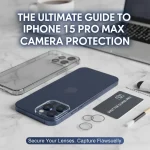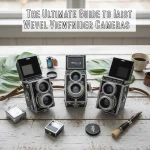[Get the best value ir night vision camera on Amazon today!]
# The Ultimate Guide to IR Night Vision Cameras [2026]
Are you looking to enhance your security, explore the nocturnal world, or simply gain a clearer view in low-light conditions? Then you’ve come to the right place! Infrared (IR) night vision cameras are rapidly evolving, offering incredible advancements in clarity, range, and features. In this ultimate guide, we’ll dive deep into the world of IR night vision, covering everything you need to know to choose the perfect camera for your needs in 2026.
[Browse top-rated ir night vision camera on Amazon]
## Understanding IR Night Vision Technology
Before we jump into specific cameras, let’s clarify what “IR night vision camera” actually *means*. In essence, these cameras utilize infrared light, which is invisible to the human eye, to illuminate and capture images in darkness.
Unlike traditional night vision, which amplifies existing ambient light (often resulting in grainy green images), IR night vision cameras actively emit their own IR light source, bouncing it off objects and back to the camera sensor. This allows for clear and detailed images, even in complete darkness.
Here’s a breakdown of key components:
* **IR Illuminator:** Emits infrared light. The strength and wavelength of this light determine the camera’s range and effectiveness.
* **Image Sensor:** Captures the reflected infrared light. Higher resolution sensors result in sharper images.
* **Lens:** Focuses the infrared light onto the sensor. Lens quality significantly impacts image clarity.
* **Processing Unit:** Converts the captured infrared data into a viewable image, often displayed in black and white or shades of green.
[Browse top-rated ir night vision camera on Amazon]
## Top IR Night Vision Cameras of 2026
Let’s dive into some of the top IR night vision cameras available in 2026. This list covers a range of applications and budgets, ensuring there’s something for everyone.
| Product | Best For |
| —————————- | ——————————————- |
| Arlo Pro 6 Night Vision | Home security, ease of use |
| ATN BinoX 4T 640 1-10x | Hunting, wildlife observation, long-range |
| Bushnell Equinox X650 | Budget-friendly wildlife observation |
### Arlo Pro 6 Night Vision
**Best For:** Home security, ease of use
**Key Features:**
* **2K HDR Video:** Captures crisp, detailed images and videos, even in challenging lighting conditions.
* **Color Night Vision:** Most IR cameras display footage in black and white, the Arlo Pro 6 can display color night vision under the right conditions.
* **Integrated Spotlight:** Provides additional illumination and acts as a deterrent to potential intruders.
* **Wireless & Weatherproof:** Easy to install and operate, suitable for both indoor and outdoor use.
**Why We Like It:** The Arlo Pro 6 excels in user-friendliness and seamless integration with existing smart home ecosystems. Its 2K HDR video and integrated spotlight provide excellent clarity and security features, making it a top choice for home surveillance. The color night vision also sets it apart from the competition.
### ATN BinoX 4T 640 1-10x
**Best For:** Hunting, wildlife observation, long-range
**Key Features:**
* **Ultra HD Sensor:** Provides exceptional image clarity and detail at long distances.
* **Ballistic Calculator:** Helps hunters accurately aim their shots in varying conditions.
* **Smart Range Finder:** Precisely measures the distance to targets.
* **Video Recording:** Captures high-quality videos of your observations.
**Why We Like It:** The ATN BinoX 4T 640 is a powerhouse of features designed for serious hunters and wildlife enthusiasts. Its ultra HD sensor, ballistic calculator, and smart range finder provide unparalleled accuracy and performance in the field. While it comes with a higher price tag, the investment is well worth it for those seeking the best in long-range night vision.
### Bushnell Equinox X650
**Best For:** Budget-friendly wildlife observation
**Key Features:**
* **Digital Zoom:** Allows for close-up views of distant objects.
* **Adjustable IR Brightness:** Optimizes image clarity for different lighting conditions.
* **Durable Housing:** Built to withstand rugged outdoor environments.
* **Day and Night Viewing:** Can be used for both daytime and nighttime observation.
**Why We Like It:** The Bushnell Equinox X650 offers a great balance of performance and affordability. Its digital zoom and adjustable IR brightness provide clear images, while its durable housing ensures reliable operation in the field. It’s an excellent choice for casual wildlife observation and those on a budget.
[Browse top-rated ir night vision camera on Amazon]
## Choosing the Right IR Night Vision Camera: A Buying Guide
Selecting the perfect IR night vision camera depends on your specific needs and priorities. Here are the key factors to consider:
* **Intended Use:** Will you be using the camera for home security, hunting, wildlife observation, or something else? Different applications require different features and performance levels.
* **Range:** How far do you need the camera to see in the dark? Consider the IR illumination range, which is typically measured in feet or meters.
* **Resolution:** Higher resolution sensors provide sharper and more detailed images. Look for cameras with at least 720p resolution, with 1080p or higher being ideal for critical applications.
* **IR Wavelength:** The wavelength of the IR light emitted by the camera can affect its visibility to animals and humans. Lower wavelengths (e.g., 850nm) are more visible, while higher wavelengths (e.g., 940nm) are less visible. Consider this factor if you need a covert camera.
* **Power Source:** IR night vision cameras can be powered by batteries, AC adapters, or solar panels. Choose a power source that is convenient for your intended use.
* **Durability:** If you plan to use the camera outdoors, make sure it is weatherproof and durable enough to withstand the elements.
* **Features:** Consider additional features such as motion detection, remote viewing, two-way audio, and cloud storage.
* **Budget:** IR night vision cameras range in price from a few hundred dollars to several thousand dollars. Set a budget before you start shopping and stick to it.
Let’s expand on some of these points with more detail:
### Understanding IR Wavelength and Covertness
The wavelength of the infrared light emitted by an IR night vision camera is a critical factor to consider, especially if covertness is a concern. Here’s a more in-depth look:
* **850nm IR:** This is the most common IR wavelength used in night vision cameras. It provides excellent illumination and range, but it also emits a faint red glow that can be visible to humans and animals, especially in complete darkness. While not as obvious as a bright light, this glow can be a giveaway if stealth is paramount.
* **940nm IR:** This wavelength is virtually invisible to the naked eye. It offers a much higher level of covertness, making it ideal for security applications where you don’t want to alert intruders. However, 940nm IR typically has a shorter range and lower illumination power compared to 850nm. You may need a more powerful illuminator to achieve the same level of visibility.
* **Trade-offs:** Choosing between 850nm and 940nm IR involves a trade-off between range/illumination and covertness. Consider your specific needs and priorities when making your decision. If you need the best possible range and image clarity, 850nm is the better choice. If covertness is essential, opt for 940nm, but be prepared for a potentially shorter range.
### The Importance of Image Sensor Size and Quality
The image sensor is the heart of any digital camera, and IR night vision cameras are no exception. The size and quality of the sensor directly impact the image clarity, detail, and low-light performance.
* **Sensor Size:** Larger sensors generally capture more light, resulting in brighter and less noisy images, especially in low-light conditions. Common sensor sizes include 1/3 inch, 1/2.8 inch, and 1/2 inch. A larger sensor will typically translate to better overall image quality.
* **Sensor Resolution:** Resolution refers to the number of pixels on the sensor, typically measured in megapixels (MP). Higher resolution sensors capture more detail, allowing you to zoom in on images without losing clarity. For IR night vision cameras, a resolution of at least 2MP (1080p) is recommended for clear and detailed images. Cameras with 4MP (2K) or higher resolution offer even better image quality.
* **Sensor Technology:** Different sensor technologies, such as CMOS and CCD, have their own strengths and weaknesses. CMOS sensors are generally more energy-efficient and offer better dynamic range, while CCD sensors tend to have lower noise levels. However, advancements in CMOS technology have largely closed the gap, and CMOS sensors are now the dominant technology in most IR night vision cameras.
### Weatherproofing and Environmental Considerations
If you plan to use your IR night vision camera outdoors, it’s crucial to choose a model that is weatherproof and durable enough to withstand the elements.
* **IP Rating:** Look for cameras with an IP (Ingress Protection) rating. This rating indicates the level of protection against dust and water. For outdoor use, a camera with an IP65 or IP66 rating
[Check the latest prices and deals for ir night vision camera on Amazon today!]









